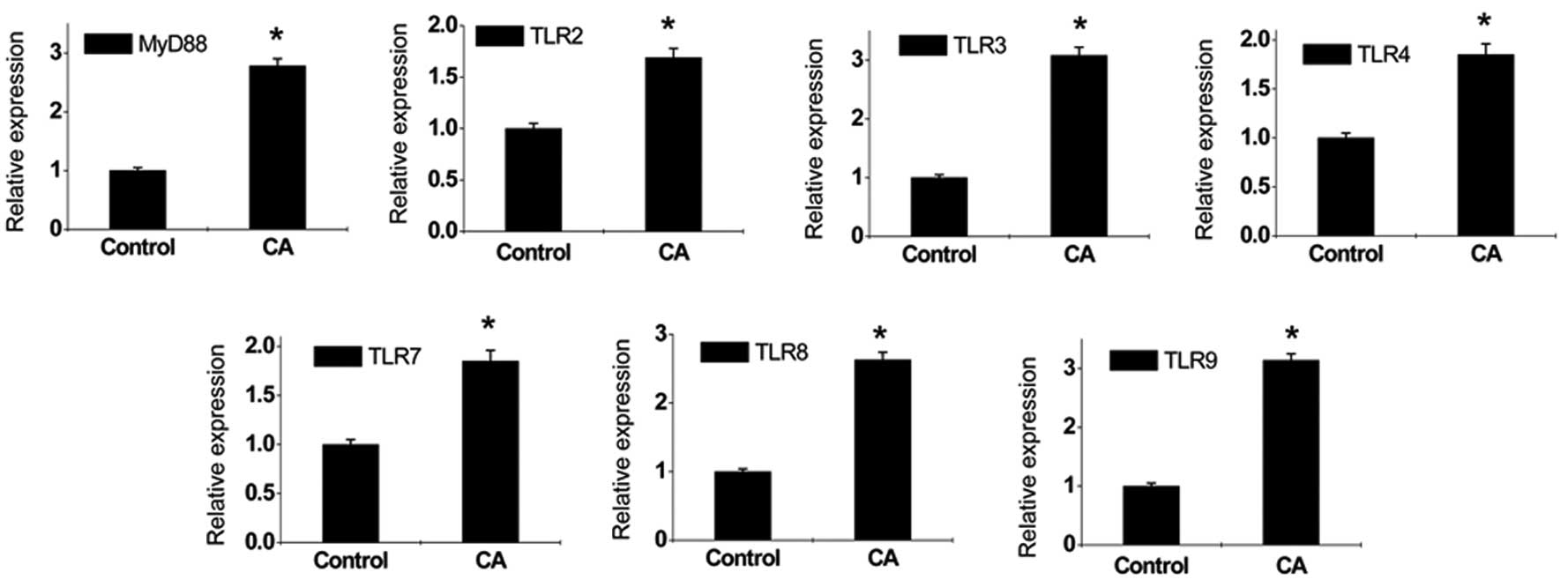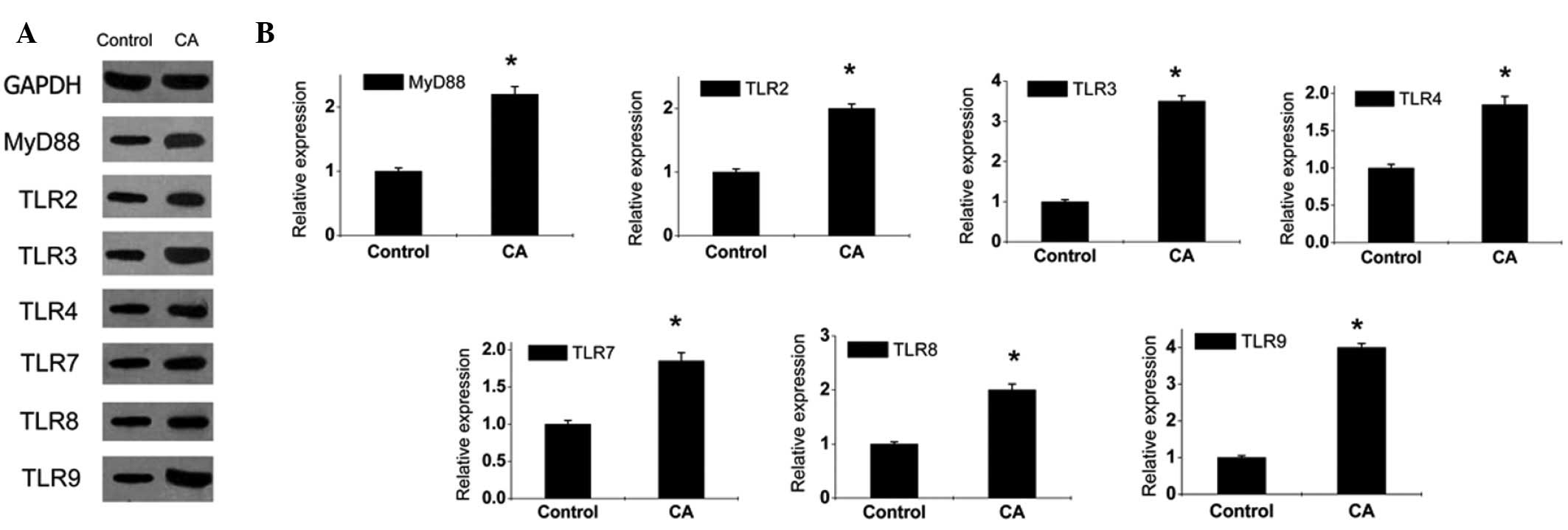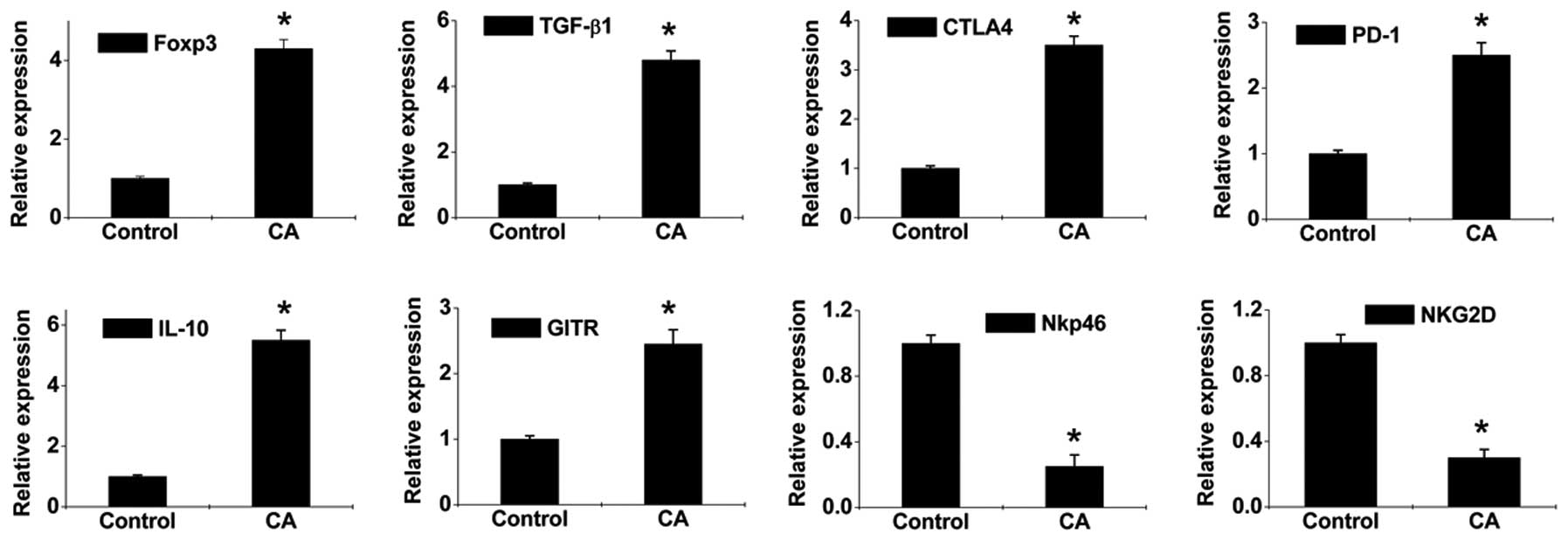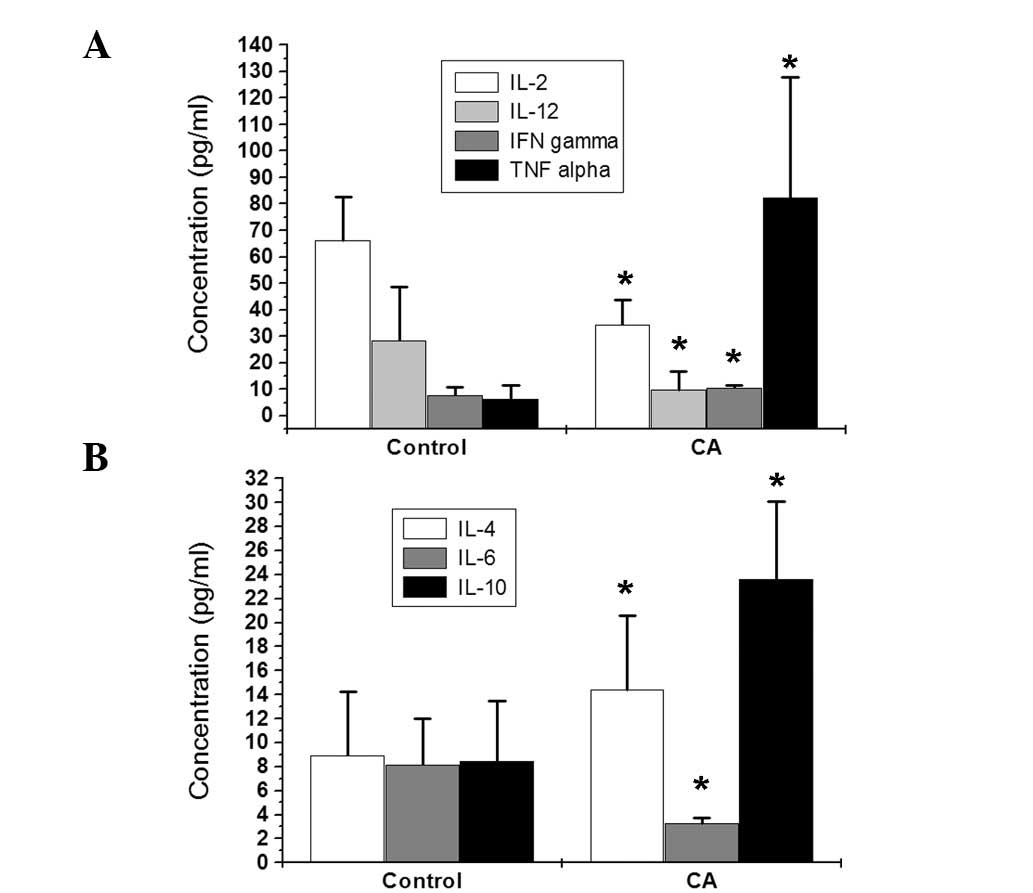|
1
|
O’Mahony C: Genital warts: current and
future management options. Am J Clin Dermatol. 6:239–243.
2005.PubMed/NCBI
|
|
2
|
McMurray HR, Nguyen D, Westbrook TF and
McAnce DJ: Biology of human papillomaviruses. Int J Exp Pathol.
82:15–33. 2001. View Article : Google Scholar
|
|
3
|
Partridge JM and Koutsky LA: Genital human
papillomavirus infection in men. Lancet Infect Dis. 6:21–31. 2006.
View Article : Google Scholar : PubMed/NCBI
|
|
4
|
Akira S and Takeda K: Toll-like receptor
signalling. Nat Rev Immunol. 4:499–511. 2004. View Article : Google Scholar
|
|
5
|
Xagorari A and Chlichlia K: Toll-like
receptors and viruses: induction of innate antiviral immune
responses. Open Microbiol J. 2:49–59. 2008.PubMed/NCBI
|
|
6
|
Sin JI: MyD88 signal is required for more
efficient induction of Ag-specific adaptive immune responses and
antitumor resistance in a human papillomavirus E7 DNA vaccine
model. Vaccine. 29:4125–4131. 2011. View Article : Google Scholar : PubMed/NCBI
|
|
7
|
Ahmed AM, Madkan V and Tyring SK: Human
papillomaviruses and genital disease. Dermatol Clin. 24:157–165.
2006. View Article : Google Scholar : PubMed/NCBI
|
|
8
|
Narayan S, Choyce A, Linedale R, et al:
Epithelial expression of human papillomavirus type 16 E7 protein
results in peripheral CD8 T-cell suppression mediated by
CD4+CD25+ T cells. Eur J Immunol. 39:481–490.
2009. View Article : Google Scholar : PubMed/NCBI
|
|
9
|
Liu XS, Leerberg J, MacDonald K, Leggatt
GR and Frazer IH: IFN-gamma promotes generation of IL-10 secreting
CD4+T cells that suppress generation of CD8 responses in
an antigen-experienced host. J Immunol. 183:51–58. 2009.PubMed/NCBI
|
|
10
|
Cao Y, Zhao J, Lei Z, et al: Local
accumulation of FOXP3+regulatory T cells: evidence for
an immune evasion mechanism in patients with large condylomata
acuminata. J Immunol. 180:7681–7686. 2008.PubMed/NCBI
|
|
11
|
Del Mistro A, Koss LG, Braunstein J,
Bennett B, Saccomano G and Simons KM: Condylomata acuminata of the
urinary bladder. Natural history, viral typing and DNA content. Am
J Surg Pathol. 12:205–215. 1988.PubMed/NCBI
|
|
12
|
Daud II, Scott ME, Ma Y, Shiboski S,
Farhat S and Moscicki AB: Association between toll-like receptor
expression and human papillomavirus type 16 persistence. Int J
Cancer. 128:879–886. 2011. View Article : Google Scholar : PubMed/NCBI
|
|
13
|
Shi YJ, Xiong F, Yang J, et al: The
expression and significance of MyD88 in condyloma acuminatum. Zhong
Guo PiFu Xing Bing Xue Za Zhi. 24:626–628. 2010.(In Chinese).
|
|
14
|
Xu Y, Zhu KJ, Zhu N, Jiang DH, Chen XZ and
Cheng H: Expression of
Foxp3+CD4+CD25+ regulatory T cells
and Th1/Th2, Tc1/Tc2 profiles in the peripheral blood of patients
with condyloma acuminatum. Clin Exp Dermatol. 34:229–235. 2009.
|
|
15
|
Villa LL, Costa RL, Petta CA, et al: High
sustained efficacy of a prophylactic quadrivalent human
papillomavirus types 6/11/16/18 L1 virus-like particle vaccine
through 5 years of follow-up. Br J Cancer. 95:1459–1466.
2006.PubMed/NCBI
|
|
16
|
Ku JK, Kwon HJ, Kim MY, et al: Expression
of Toll-like receptors in verruca and molluscum contagiosum. J
Korean Med Sci. 23:307–314. 2008. View Article : Google Scholar : PubMed/NCBI
|
|
17
|
Yang R, Murillo FM, Cui H, et al:
Papillomavirus-like particles stimulate murine bone marrow-derived
dendritic cells to produce alpha interferon and Th1 immune
responses via MyD88. J Virol. 78:11152–11160. 2004. View Article : Google Scholar : PubMed/NCBI
|
|
18
|
Ochs HD, Gambineri E and Torgerson TR:
IPEX, FOXP3 and regulatory T-cells: a model for autoimmunity.
Immunol Res. 38:112–121. 2007. View Article : Google Scholar : PubMed/NCBI
|
|
19
|
van Maren WW, Jacobs JF, de Vries IJ,
Nierkens S and Adema GJ: Toll-like receptor signalling on Tregs: to
suppress or not to suppress? Immunology. 124:445–452.
2008.PubMed/NCBI
|
|
20
|
Caramalho I, Lopes-Carvalho T, Ostler D,
et al: Regulatory T cells selectively express toll-like receptors
and are activated by lipopolysaccharide. J Exp Med. 197:403–411.
2003. View Article : Google Scholar : PubMed/NCBI
|
|
21
|
Khattri R, Cox T, Yasayko SA and Ramsdell
F: An essential role for Scurfin in CD4+CD25+ T regulatory cells.
Nat Immunol. 4:337–342. 2003.PubMed/NCBI
|
|
22
|
Hori S, Nomura T and Sakaguchi S: Control
of regulatory T cell development by the transcription factor Foxp3.
Science. 299:1057–1061. 2003. View Article : Google Scholar : PubMed/NCBI
|
|
23
|
Sakaguchi S, Wing K, Onishi Y,
Prieto-Martin P and Yamaguchi T: Regulatory T cells: how do they
suppress immune responses? Int Immunol. 21:1105–1111. 2009.
View Article : Google Scholar : PubMed/NCBI
|
|
24
|
Huber S, Schramm C, Lehr HA, et al:
Cutting edge: TGF-beta signaling is required for the in vivo
expansion and immunosuppressive capacity of regulatory
CD4+CD25+ T cells. J Immunol. 173:6526–6531.
2004. View Article : Google Scholar : PubMed/NCBI
|
|
25
|
Molling JW, de Gruijl TD, Glim J, et al:
CD4(+)CD25hi regulatory T-cell frequency correlates with
persistence of human papillomavirus type 16 and T helper cell
responses in patients with cervical intraepithelial neoplasia. Int
J Cancer. 121:1749–1755. 2007.
|
|
26
|
Sun J, Walsh M, Villarino AV, et al: TLR
ligands can activate dendritic cells to provide a MyD88-dependent
negative signal for Th2 cell development. J Immunol. 174:742–751.
2005. View Article : Google Scholar : PubMed/NCBI
|
|
27
|
Kaisho T, Hoshino K, Iwabe T, Takeuchi O,
Yasui T and Akira S: Endotoxin can induce MyD88-deficient dendritic
cells to support T(h)2 cell differentiation. Int Immunol.
14:695–700. 2002. View Article : Google Scholar : PubMed/NCBI
|
|
28
|
Bais AG, Beckmann I, Lindemans J, et al: A
shift to a peripheral Th2-type cytokine pattern during the
carcinogenesis of cervical cancer becomes manifest in CIN III
lesions. J Clin Pathol. 58:1096–1100. 2005. View Article : Google Scholar : PubMed/NCBI
|



















